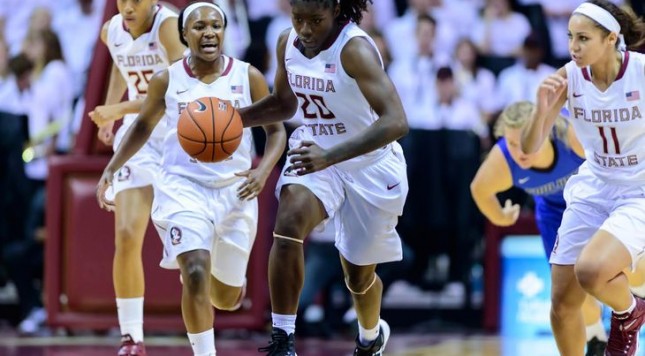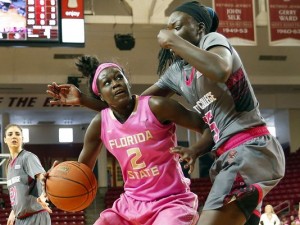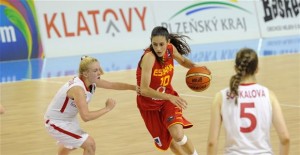By many metrics, the 2014-2015 women’s basketball season was the best in Florida State history. Breaking at least four different records and receiving multiple national and ACC awards had the entirety of Tallahassee behind the ‘Noles on their quest for a title.
While it didn’t end with the team hoisting a trophy, that doesn’t mean the season was a disappointment — far from it in fact. Many fans saw that the team was firing on all cylinders, it was just that they ran into teams that were better. When you get to the Elite Eight, that list of teams gets pretty small.
With all this in mind, it should be exciting for FSU fans to see what’s in store for next season. Why?
Because next year’s team will be better.
Yes, it seems like such a feat would be hard to accomplish considering just how far the team went last season. But returning production is very high and there were only two seniors on last year’s team with just one, Maegan Conwright, having an instrumental role.
Four players in total are leaving: Conwright, Lauren Coleman, Morgan Jones, and Shakena Richardson. The first two graduated and the latter two are transferring out of the program. Jones was a starter for 21 games who averaged around 21 minutes per contest while Richardson was used sparingly at 12 minutes-per-game.
In all, Florida State returns 71 percent of its point production, 82 percent of its rebounding, and 72 percent of its defensive production (blocks plus steals). These are great numbers to have in a conference where competition is stiff and young teams get eaten alive in big games.
A (potential) starting lineup consisting of Leticia Romero, Brittany Brown, Ivey Slaughter, Shakayla Thomas and Adut Bulgak has one senior, three juniors, and a sophomore on it. Two All-ACC selections and the Sixth Player of the Year are retained from last year’s squad that went deep into the tournament.
Numbers are only half the story however. It’s not unheard of for teams to return a large majority of their production only to see their leadership depart as well and leave them in dire straits. This will be the dilemma for the Seminoles next year in dealing with the departure of Conwright. Not only did she bring great point guard play, but she brought an energy and veteran presence that can’t truly be measured by any number on a stat sheet.
It was her leadership that allowed FSU to win close games like Arizona State and not come out stale against tournament teams Florida Gulf Coast and Alabama State. Later in the season, it became apparent that Romero was coming along in a similar fashion, and we should probably expect her to emerge in a similar role next season.
Florida State has also taken steps to avoid the potential drop-off coming from such situations. In the past few months, three new players have come to FSU either as transfers or as part of signing classes. Those three are Spain’s Maria Conde, Australia’s Rachel Antoniadou, and former Baylor player Imani Wright.
Conde, like Romero, is an international player from the Spanish League who came on strong in her second year of playing for Los Estudiantes. She averaged 15.8 points-per-game, 6.7 rebounds-per-game, and 1.7 assists-per-game in her most recent season with the team.
Conde is a small forward who Coach Sue Semrau describes as a “…a long athlete who is a slasher and possesses a very good basketball IQ.”
One would think she’d mainly be used when the Seminoles need to attack the basket and control the paint, whereas players like Slaughter would mainly be used for disruption on defense and the occasional scrappy putback. In fact, Conde has a similar build to Slaughter and both are praised for their length. If she works on her defense and can lean on her team to start out, she could very well be the main reserve at the small forward position.
The good thing about international players like Conde is that they have been facing fairly elite competition by participating in multiple FIBA tournaments throughout the developmental years. Romero was in a similar boat when she first went to Kansas State and everyone saw that she adapted to the college game quicker than a lot of American high school players. The Seminoles are hoping that both Conde and Antoniadou can do the same.
Antoniadou was the next signing for the ‘Noles and came only a week after the Conde news. In contrast to Conde, Antoniadou is a guard whose strengths lie in her passing and long range game. She has played for the Dandenong Rangers in both the South East Australian Basketball League and the Women’s National Basketball League. Antoniadou has also competed in the regional FIBA tournaments and averaged 9.2 points, 3.3 rebounds, and 3.2 assists in the recent 2014 Oceania Championship.
It’s unlikely that she’ll get much time initially behind Brittany Brown and Leticia Romero, but she will provide depth that the departure of Jones took away. Should she learn from those in front of her, Antoniadou has the potential to be a good starter at Florida State.
Imani Wright won’t be able to play until the 2016 season so we won’t be focusing on her too much, but it is important to note that she will most likely be the shooting guard of the future when she becomes eligible. Wright is exceptionally talented and was a key starter on a Baylor team that also went to the Elite Eight last year. She averaged 9.4 points, 3.2 rebounds, and 2.1 assists last season.
All three of these players will in someway factor into the future of FSU women’s basketball, with the first two being more immediate. Losing Conwright is the biggest hurdle this team faces and very few will deny that. But it’s important to remember that the Seminoles are headed by the 2014 Coach of the Year and living FSU legend Sue Semrau. Great coaches have a way of working out their team to find who the on-court leaders are and how to maximize their potential and Semrau is no exception.
Beyond that, the returning cast members mean that Florida State will once again put on a show for its loyal fans. Bulgak is currently on the Canadian women’s developmental team, Thomas is with the U.S. U19 team, and Romero is playing for the Spanish national team. With such a strong core, it’s hard to see the Seminoles dropping off much.
This idea becomes even harder to imagine when looking around the ACC. Notre Dame was Florida State’s biggest folly last season and the Fighting Irish just lost their best player Jewell Loyd in a controversial decision on her part to leave early. North Carolina experiences the same situation, except its best player Allisha Gray chose to transfer.
Louisville had an unexpectedly good season last year, but it just lost four of its top six scorers from that squad. The three biggest threats last season to a Florida State ACC championship have all experienced setbacks.
The biggest challengers next year for FSU would seem to be Syracuse and Duke. The Orange are actually very similar to the Seminoles in regards to returning starters. They lose only one senior starting guard in Diamond Henderson while still returning their best player Alexis Peterson and the core of the 2014 team.
Syracuse got to the second round of the NCAA tournament last year before having the unfortunate luck of running into the steamroller that was South Carolina. Duke is in the middling position where it returns a handful of its talented players but still lose a good amount of seniors. It would be wise to hold off on naming the Blue Devils as a threat until they can show next season that they are able to fill in the missing pieces.
It should also be noted that Romero didn’t even start a full season but is still widely regarded as one of the best point guards in the nation. In just 24 games, she was able to become a top three scorer and the leading assister on the team. She did this all while shooting better than 54 percent from the field, which was the highest of any player that started a game for the Seminoles.
If Romero can reduce the turnovers next season, she could be in contention for national awards. Conwright leaving might put a lot of responsibility on her, but she has shown that she can handle it. Expect a great season from Romero.
If there is a chance for FSU to go even further than last season, it is probably now. The Seminoles return almost all of their essential starters and will compete in a conference expected to be on the downswing. It’s currently too soon to call them a championship team — those only emerge later in the season after seeing how they respond to adversity. But the Seminoles are primed. They are primed for an ACC championship, an NCAA Tournament run, and an overall great season.
Watch out for the ‘Noles.






















